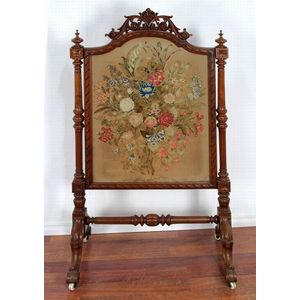French Oak Buffet with Etruscan Carvings and Floral Details
You must be a subscriber, and be logged in to view price and dealer details.
Subscribe Now to view actual auction price for this item
When you subscribe, you have the option of setting the currency in which to display prices to $Au, $US, $NZ or Stg.
- Etruscan - The Etruscans were pre-Roman people who mainly inhabited central and part of north Italy, in the area corresponding to Tuscany. The civilisation was active from around 700BC until their assimilation into the Roman Empire in around the 4th century BC.
With the increasing importance of Rome they were virtually wiped out, for Rome would not tolerate a competitive civilization. Many Etruscan rituals and aspects of their culture were taken over by Rome: Etruscan funeral games became the Roman gladiatorial combats and the science of divination came from the Etruscans.
They were also incredible craftsmen in precious metals. It was said that the famous Etruscan Sibylline books of received wisdom were burnt by Rome and that the emperor Claudius was the last person who could read Etruscan, a language that is still largely undeciphered.
Black and red figure vases attributed to the Etruscans provided the basis for the Etruscan style of furniture, decorative arts and decoration first seen in Louis XVI furniture in the 1760s, and then adapted by Robert Adam in England.
The style was characterised by the use of the red and black colourways of the vases, together with motifs such as lions, birds, sphinxes and griffins.
Josiah Wedgwood was inspired by the civilisation, and in 1769 he opened his new ceramic factory at Stoke-on-Trent, naming it "Etruria Works". Using the modeller John Flaxman, he produced wares based on what was thought at the time, to be Etruscan themes.
At the end of the 18th and in the early 19th century, Etruscan themes were seen in glass, jewellery and furniture, and in the 1820s Coalport China produced a range of wares based on the Etruscan themes.
Around that time it was discovered that the archaeological treasures attributed to the Etruscans were of Greek origin, but the description of them as "Etruscan" continued. - Frieze - An architectural term denoting the flat, shaped or convex horizontal surface of furniture, between the architrave and the cornice, usually found on a cabinet or bookcase, or on desks and tables where it may include drawers, the area between the top and the legs. In ceramics, the term refers to the banding, of usually a repeating pattern, on the rims of plates and vases.
- Etruscan Revival Style - The Etruscan revival style is based on the ancient art and architecture developed by the Etruscan civilization that lived in central Italy between the 8th and 3rd centuries BCE. In ceramics and decorative arts the Etruscan style is characterised by its ornate and intricate designs, as well as its use of vibrant colours. Etruscan pottery was often decorated with scenes from daily life, myths and legends, and animal and floral motifs, rendered in relief or painted. Etruscan metalwork, such as jewellery and vessels, also displayed a high degree of skill and sophistication, with intricate designs featuring mythical creatures and animals. Additionally, the Etruscan style is known for its use of the bucchero technique, which involved creating a black, matte surface on pottery by reducing the oxygen in the firing process. This style of decoration was widely adopted by other cultures in the ancient Mediterranean world.
- Oak - Native to Europe and England, oak has been used for joinery, furniture and building since the beginning of the medieval civilisation. It is a pale yellow in colour when freshly cut and darkens with age to a mid brown colour.
Oak as a furniture timber was superceded by walnut in the 17th century, and in the 18th century by mahogany,
Semi-fossilised bog oak is black in colour, and is found in peat bogs where the trees have fallen and been preserved from decay by the bog. It is used for jewellery and small carved trinkets.
Pollard oak is taken from an oak that has been regularly pollarded, that is the upper branches have been removed at the top of the trunk, result that new branches would appear, and over time the top would become ball-like. . When harvested and sawn, the timber displays a continuous surface of knotty circles. The timber was scarce and expensive and was used in more expensive pieces of furniture in the Regency and Victorian periods. - Apron - A decorative wooden panel that sits underneath the top surface of a table or chair, and unites the top of the piece with the legs, running at right angles to the underside. On carcase furniture such as a chest or wardrobe, the apron sits below the drawers or doors and attaches to the legs.
On carcase furniture without legs the panel under the drawers or doors sits on the floor and is termed a plinth.
An apron can provide a decorative touch to an otherwise unadorned piece of furniture and at the same time provide structural support and strength. They can be carved or pierced and quite elaborate.
This item has been included into following indexes:
Visually similar items

Hermes, silk Turban hat, with gold scarf ring detail, padded mesh lining and grosgrain trim, labelled 'Hermes Paris', with original box, height 11.5 cm diameter 20 cm

Bvlgari, python handbag, black snakeskin and smooth leather drawstring closure, gold tone hardware, two chain link shoulder straps with coloured glass medallion detail, textile lining with interior zip pocket, stamped 'Bvlgari, Made in Italy, height 27 cm

A Victorian heart shaped porcelain scent bottle painted with a scene of a courting couple, sterling silver screw cap, English circa 1900, 5.5 cm long

A Victorian walnut fire screen, the arched top inset with wool work on end fluted columns, each with out swept supports. 149 cm high, 85 cm wide.
